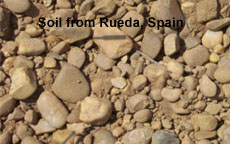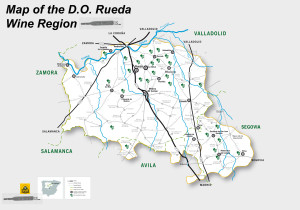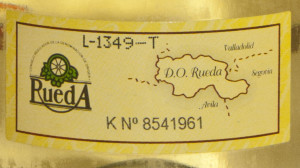RUEDA WINES
When you are having a wine from the grape variety of Verdejo, you are most likely having a Spanish wine from Rueda. Rueda is an appellation in the Castilla y Leon region located in the north western part of Spain which is about 100 miles from Madrid.
Denominacion de Origen
The main wine growing areas in Rueda are La Seca, Rueda and Serrada. The Rueda appellation is located on elevations of 2,300 to 2,600 feet above sea level with exposure to the cooling Atlantic winds. Because of these heights, the vineyard climates are actually Continental. The winters are long and very cold. Spring is short with possible frost and summers are hot and dry. There are more pine trees than olives trees here. The physical location geographically of Rueda would be considered Mediterranean. Rainfall is low. Annual sunshine can be as high 2,600 hours but with the high altitude the nights are cool which preserves the acidity and allows the fruit and its sugars to be at the proper balance. It is not uncommon to have in the height of the summer 95F degree days and for the temperature to drop to 60F degrees at night. Also, the stones retain the heat from the day and radiate it back to the vines during the night.
 The soils for the most part are dark grayish brown, pebbly, sandy and rich in calcium and magnesium. At the tops of some of the hills limestone can be found. Having sandy topsoil and gravely deposits makes this a quick draining soil.
The soils for the most part are dark grayish brown, pebbly, sandy and rich in calcium and magnesium. At the tops of some of the hills limestone can be found. Having sandy topsoil and gravely deposits makes this a quick draining soil.
Prior to the 1970’s, Rueda produced old styled traditional wines. Then the wine was barrel fermented and aged for a long time. This was before there was easy access to temperature controlled stainless steel tanks. Today Rueda focuses on young fresh white wines made in these stainless steel tanks. There is also a tiny amount of red wine that is produced but they are kept for domestic consumption. This is another good reason to visit the wine region.
Verdejo
Verdejo is the main white grape variety of Rueda and is indigenous to Rueda. It is believed to date back to the 16th century. The Verdejo grape grows in medium sized bunches with short stems. The berries are medium size and like to be close to each other. With the skin being so light colored and thin, the seeds (pips) can be seen from the outside. Also, the thin skin makes this an early ripening grape. Verdejo in Reudo is resistant to disease and does not give large productions per vine. With its hardy woody trunks, the vines can survive the harsh winters in this Continental climate region. .The grape variety here has the characteristics of having great aromatics and floral scents like Sauvignon Banc and Viogner. It combines both of these grapes characteristics into the unique Verdejo grape variety. It is aromatically complex with white flowers, fruit and some minerality. It blends the citrus with richness and it natural touch of herbaceousness in an elegant fashion.
It can also be compared with a Bordeaux Sauvignon at a significantly lower price point. The Verdejo has the same aromatics and has more of a body feel with some minerality found in a Bordeaux Sauvignon than Sauvignon from the Loire Valley.
It is grown elsewhere in and out of Spain but it is at its highest expression in Rueda.
Viura
This variety is mainly used as a blending grape. Viura blended with Verdejo gives the extra lightness and slight more acidity. This variety also goes by the names of Macabeu(France) and Macabeo(Catalonia).
Sauvignon Blanc
Sauvignon Blanc is the secondary variety in Rueda. The intention of growing this variety was to help get attention to the region with such a well known grape variety. In a blend, this adds stronger flavors of grapefruit and with passion fruit while giving floralness. It is a little more fruity than Verdejo and ripens earlier.
Palomino Fino
Palomino Fino was and is. This is the wines that sherry is made from. Historically this variety had been planted but it is no longer allowed to be planted. As a wine it is a neutral tasting wine and is a wine of low quality and therefore is not in accordance with the regions goal of high quality wine production.
Red Wine Varieties
It is not for certain how the decision came to be that the focus would be on producing white wines but tin Rueda. They also grow Tempranillo, Cabernet Sauvignon, Merlot and Grenache. Wines made from these varieties do not make their way outside the country.
The Numbers
Verdejo is the most widely planted grape variety in Rueda. The 2012 harvest resulted in 99% white grape varieties. Verdejo represented 86% , 9% Viura and 5% Sauvignon Blanc.
The Official Seal
On the back of each bottle there is an official seal and guarantee of the identity and origin of the product. It also guarantees that the wine has been produced in accordance with the quality standards imposed by the Rueda Control Board. Here is a sample of the seal found on a bottle of Verdejo.
The Reuda Control Board
In 1980 Rueda was given its official status as a Denominacion de Origen(D.O.) in the region of Castilla y Leon. A control board was established to enforce the national and regional regulations in viticulture and harvesting practices that must be followed being a D.O. Before bottling there is a tasting committee that has the final approval if the wines meet the rules and regulations including quality control.


